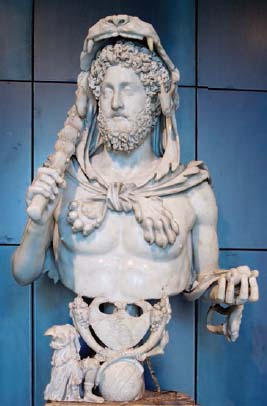Art of the Ancient World, C. 5000 B.c.e.–400 C.E.Roman Art |
How did Romans make their mosaics? |
Mosaics were very popular in ancient Rome and, like realistic wall paintings, were used extensively to decorate the floors of private homes and villas of the wealthy. At the heart of a Roman mosaic are tesserae, small pieces of glass and stone, often in a cube shape. The tesserae were pressed into cement, which was also used as a sort of grout in the spaces between the stones. Mosaic panels, called emblamata, were usually built off-site by the mosaic artist and then installed into a floor. Romans liked to copy famous paintings in mosaic form, which required very tiny pebbles in order to achieve the detail of a painting. A number of lost Greek paintings still exist in a Roman mosaic form.

Emperor Commodus is laughable dressed as the mythological hero Hercules. Emperor Commodus was known for his strange, often unstable, behavior.
